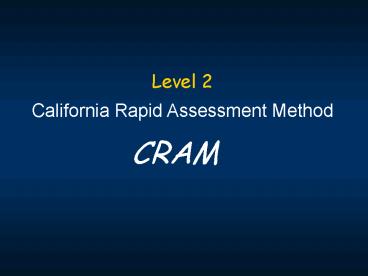Level 2 - PowerPoint PPT Presentation
1 / 52
Title:
Level 2
Description:
Provide timely, standardized, inexpensive assessments of wetland and riparian condition ... lacustrine, estuarine, coastal lagoon, riverine and riparian, depressional, ... – PowerPoint PPT presentation
Number of Views:35
Avg rating:3.0/5.0
Title: Level 2
1
Level 2 California Rapid Assessment Method
CRAM
2
Purpose
Provide timely, standardized, inexpensive
assessments of wetland and riparian condition
3
Geographic Scope All wetlands of all types in
California
lacustrine, estuarine, coastal lagoon, riverine
and riparian, depressional, vernal pools, playas,
seeps and springs
Initial focus is on coastal watersheds
4
What is CRAM?
- Expert walk and talk diagnostic tool
- A standard set of questions with mutually
exclusive multiple choice answers for each
wetland class - Less than 4 hrs of field time per assessment for
2-3 person team - Required expertise comparable to jurisdictional
delineation
5
Attributes of Condition, which have
Hierarchy of CRAM Structure
Same for all Wetlands Classes
Wetland Sites, have one or more
Assessment Areas, for which there are
Metrics, which have
Vary among Wetland Classes
Alternative States, which have
Scores (relative to best achievable)
6
Four CRAM Attributes
Wetland Condition
Landscape Context
Hydrology
Physical Structure
Biotic Structure
7
CRAM Attributes Metrics
Wetland Condition
Landscape Context
Hydrology
Physical Structure
Biotic Structure
Landscape Connectivity
Buffer
8
CRAM Attributes Metrics
Wetland Condition
Buffer
Hydrology
Physical Structure
Biotic Structure
Water Source
Hydroperiod
Hydrologic Connectivity
9
CRAM Attributes Metrics
Wetland Condition
Buffer
Hydrology
Physical Structure
Biotic Structure
Structural Patch Richness
Topographic Complexity
10
CRAM Attributes Metrics
Wetland Condition
Buffer
Hydrology
Physical Structure
Biotic Structure
Organic Matter Accumulation
Interspersion Zonation
Plant Comm. Composition
Vertical Biotic Structure
11
Stressors are Identified
Wetland Condition
Landscape Context
Hydrology
Physical Structure
Biotic Structure
Stressor Checklist
12
Reference Concepts
Metrics are scored relative to the best
achievable condition, which is standardized
throughout the state for each wetland class.
A network of low to high scoring reference sites
is needed for each wetland class in each region.
13
Next Steps
CRAM 4.3 and CRAM IT for 2007 will include
adjustments based on 2006 field experience.
14
Wetland Tracker
15
Wetland Tracker
- Information system for wetlands and riparian
habitat - Methodology
- Field software
- Website
16
Goals
- Track net change in extent and condition of
habitat - Enhance stewardship of habitat
17
Geographic Scope
Designed for all of CaliforniaData available
for San Francisco Bay (Region 2) baylands
Limited data available for Central Coast
(Region 3), Morro Bay regionData collection
Southern California Coast
18
(No Transcript)
19
(No Transcript)
20
Information in Tracker
- Maps of current and historical wetlands
- Inventory of wetland projects
- Selected wetland condition (CRAM)
21
Information in Tracker
- Maps of current and historical wetland
- Inventory of wetland projects
- Selected wetland condition (CRAM)
22
Wetland Project Inventory
- List of projects
23
(No Transcript)
24
(No Transcript)
25
Wetland Project Inventory
- List of projects
- Map of projects
26
(No Transcript)
27
Wetland Project Inventory
- List of projects
- Map of projects
- Project information
28
- Status Planned, In-progress, completed
- Details Size, planned habitat, contacts, events,
etc. - File library permit documents, project maps,
performance criteria, monitoring reports
29
- Status Planned, In-progress, completed
- Details Size, planned habitat, contacts, events,
etc. - File library permit documents, project maps,
performance criteria, monitoring reports
30
Wetland Project Inventory
- List of projects
- Map of projects
- Project information
- Summary reports
31
(No Transcript)
32
(No Transcript)
33
Information Flow
34
(No Transcript)
35
Information in Tracker
- Maps of current and historical wetland habitats
- Inventory of permitted wetland projects
- Selected wetland condition (CRAM results)
36
Information in Tracker
- Maps of current and historical wetland habitats
- Inventory of permitted wetland projects
- Selected wetland condition (CRAM results)
37
Measuring Condition
38
(No Transcript)
39
Measuring Condition
40
Measuring Condition
41
Viewing Condition
42
Viewing Condition
43
Viewing Condition
44
Viewing Condition
45
Viewing Condition
46
Discussion
Tracking net change is not the job of any
particular agency, department, or program
Tracking net change
47
Discussion
Tracking tools must provide a net benefit to
existing programs, which in turn can help track
net change
48
Discussion
Example Track 401 projects in ways helpful to
the Water Boards. Tracking net change can be
accomplished as a byproduct of 401 permitting.
49
Discussion
What other programs might benefit from helping
to track net change?
50
Discussion
Project tracking priorities
51
Discussion
- Priority 1 401 projects
- Priority 2 CDFG 1600 projects, State Refuges and
Parks - Other Priority 2 Federal 404 projects, Grant
Projects (e.g., habitat projects funded through
Consolidated State Grants, Proposition 84, 319h,
etc).
52
www.iep.water.ca.gov































